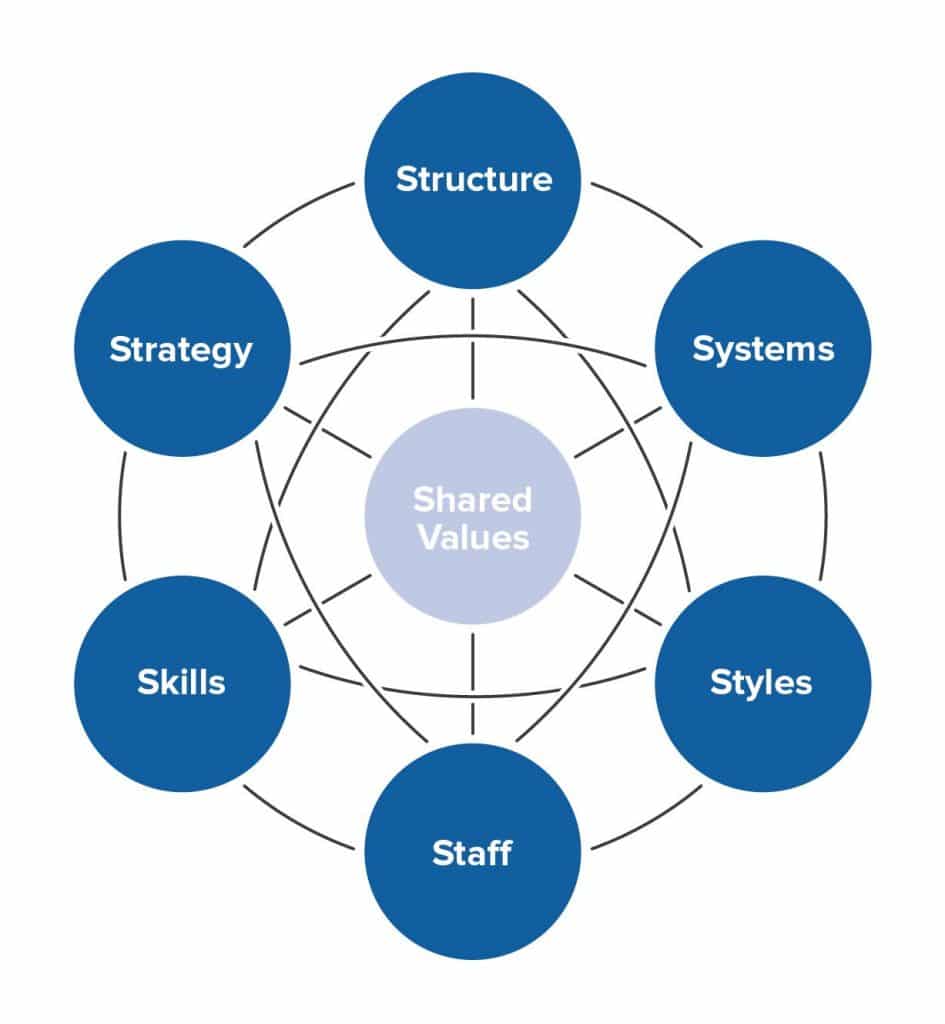The McKinsey 7S Framework was introduced in the 1970s in the book In Search of Excellence, by former McKinsey consultants Thomas J. Peters and Robert H. Waterman. This Framework maps a constellation of interrelated factors that influence an organisation’s ability to change. Almost 50 years later, this model still shows its validity both as a Change Management and Organisational Design tool.
The model is fascinating not just to support a Change process, but also to investigate why you should change. It analyses seven aspects of your organisation set-up, and how they affect each other. Through the model, you will be able to highlight the changes you need to make to create a consistent approach to Change.
The seven elements of the McKinsey 7S Framework are divided into two groups:
- Hard S
- Strategy
- Structure
- Systems
- Soft S
- Shared values
- Style
- Staff
- Skills
The Model

The McKinsey 7S Framework can be applied to many situations and is a valuable tool when the organisational design is in question. The most common uses of the Framework are:
- To facilitate organisational Change.
- To help implement a new strategy.
- To identify how each area may change in the future.
- To facilitate the merger of organisations.
Let’s now see in detail the components of the model, starting from the Hard Factors.
Strategy
The first element in this Framework is an Assessment of your organisation’s Strategy. The Strategy needs to be formal enough to allow you to sustain your Purpose and maintain or gain an advantage over your competition. It should also be flexible enough to adapt to changes quickly, without destroying value. When assessing your Strategy, it’s a good habit to answer questions like:
- What are your objectives?
- What is your Strategy to achieve them?
- How are you staying competitive?
- How can your Strategy adapt to the current (and future) situation?
Structure
Represents how your organisation is structured in terms of business divisions and units and includes information about who is accountable to whom. It should be relatively simple to note down but be careful; it’s not just your Org Charts. More and more in recent years, we have seen the importance of Networking Analysis to really identify the informal structure of your organisation, rather than focusing only on the formal aspect.
A few guiding questions can be:
- How is your company structured (departments, teams, etc.)?
- What is your hierarchy?
- How are your departments organised and managed?
- How are your teams organised and managed?
- How do your individual team members organise themselves?
- Who makes the decisions?
- How are they carried out/passed down?
- How does everyone communicate?
- How often does communication flow?
- How does collaboration happen?
- What is the informal structure of your organisation?
Systems
The third “hard” aspect it’s about the process, procedure and technology that your organisation has implemented. You need however here as well to try to identify not just the “formal” part of your business systems, but also the informal elements, as these are often clear indicators of the need to change.
A few guiding questions can be:
- What are the core systems in your business (ERP, finance, HRIS, document management, team management/meetings, etc.)?
- What are the core Policies/Procedures of your organisation?
- How are these policies and/or procedures stored, accessed and used?
- How are they updated (and are they up to date)?
- How do you track and assess the results of these processes?
- Who has access to these systems?
- How many exceptions are managed through the processes? What are the reasons for these exceptions?
- What alternative, non-official systems are in use among the users of the organisation? (an examp[le could be the usage of Whatsapp as a communication tool, free accounts of Slack etc.).
This is the first of the Soft elements of the Framework. This is both about analysing the formal and informal values of your organisation, by checking the behaviours your employees’ display. Culture is one of the critical components for being able to sustain Change, and often it becomes the most significant barrier to the successful implementation of a transformation programme.
Being able to link the Change needed to existing core values and principles is going to be a tremendous facilitator for your change process.
Here a few guiding questions:
- What are your core company values?
- What is your company culture?
- What are your teams’ cultures?
- What behaviours are displayed by individuals in the organisation?
- Are they at odds with the company culture?
- How could you strengthen them in practice?
Style
This element is about assessing the management and leadership style of the organisation. In the original model (remember that it was written in the 70s), it was really about identifying the management style of the Leaders. Today, it’s instead essential to examine working style as well, at different levels of the organisation. For example, Collaboration vs competition is a crucial element in why the working style displays itself.
Again, let’s see a few guiding questions:
- How is your organisation managed?
- What is the management style of your leadership team?
- What is the management style of other levels of the organisation?
- What is the working style that employees display more frequently?
- Does your organisation inspire competition or collaboration?
Staff
This element is about understanding your teams more in detail, assessing whether you have required positions filled, what gaps exist, what the attrition is, what their time horizon (how many people will retire in the coming years for example). It’s an area that the development of People Analytics highly influences today.
Let’s see some guiding questions:
- What positions do you have filled?
- What are the gaps in the organisation?
- What is the attrition level?
- What level of diversity exists?
- What is your Workforce Strategy? Is there a Plan?
Skills
Finally, you should have a look at the competencies your employees have. This is not just about analysing the existing stock superficially, but also identifying the skills required for the future. In today’s world, it is also essential to focus on the internal perception of existing skills by managers and employees.
Here some guiding questions:
- Do your employees have the necessary skills to do their job to the desired quality?
- What skills are not present in your company?
- How vital are these missing skills?
- What are the strongest skills across your company/teams?
- How are you assessing these skills?
- What is your company perceived as doing well, and what skills does that reflect on?
- How do you increase skills in the organisation?
Consistency in the Model
Once you have checked the model and done your analysis, you should check how each affects the others. Your review should focus on the following aspects:
- Consistency
- Alignment
- Conflicts
- Gaps
- Support
- Strengths
- Weaknesses
What is particularly important is to check which elements of the Framework supports the other, and which one instead is creating inconsistencies. For example, it’s not uncommon to see organisations with Structures that do not help Strategy, or with Skills that are not aligned with the existing Systems.
Through this analysis, you should then be able to plan your Change Strategy through the following steps:
- Step 1: Determine the optimal organisation design
- Step 2: Determine where and what changes should be made
- Step 3: Make the necessary changes
- Step4: Keep the 7S Framework continuously monitored.
It’s key to remember that all elements of the Framework should be given equal importance to achieve the best results.
What’s good about the model
The McKinsey 7S Framework is excellent in showing the weaknesses of the current status of your organisation and can highlight the areas that require the most attention when deploying a change. Beyond that, it helps to ensure all aspects of your organisation consistently support the Change process.
I genuinely think that Consistency is the critical feature of this model in approaching Change, provided the rule of giving equal attention to each component is respected.
What’s bad about the model
It’s a complex model, which requires a lot of attention and care in its application. Often external support is needed in this Framework to be holistically applied. One defect in its application is that way to often the Hard Components get a lot more attention than the Soft ones, as these are easier to be analysed.
The other risk is that often the concentration is only on the formal aspects of each component, rather than on the informal ones which usually are those more impacting the Change.
Conclusion
More than a Change Management like Lewin’s or Kotter’s, the McKinsey 7S Framework is a helpful diagnostic tool to initiate and sustain Change. Complex to be applied, as it requires much effort in the set-up phase, it provides a way to balance all required elements in a transformation process. Used in conjunction with other Models will indeed display its real value.
This post belongs to a series of articles related to Change Management. An introductory article: Change Management: The 10 Best Approaches & Models is available, containing links also to all other posts of the series.

Cover Photo by Markus Spiske on Unsplash

[…] Congruence Model is a framework conceptually similar to McKinsey’s 7-S, as it looks at giving a holistic picture of the components of the organisation that can affect a […]
[…] and planning. In that case, it can better be used as an integration, for example, to models such as McKinsey or the Nadler-Tushman Congruence model who allow to better define the direction of the Change […]